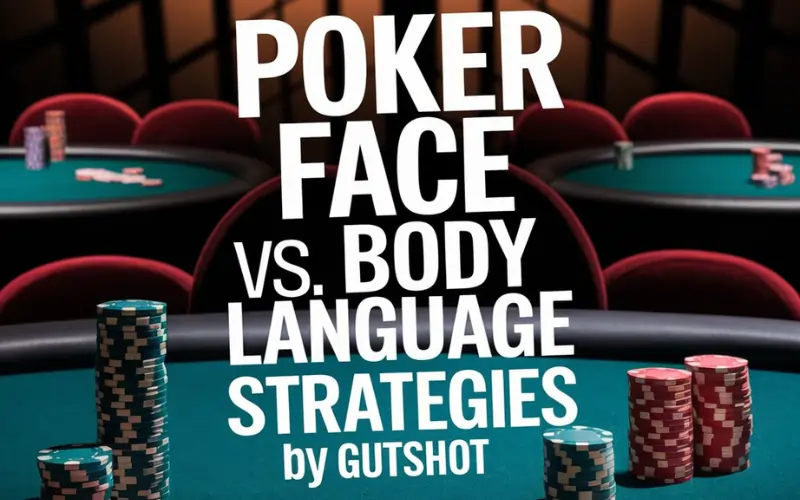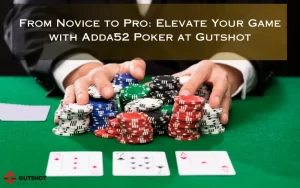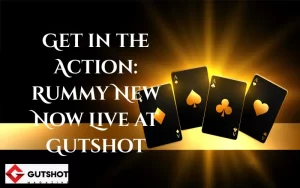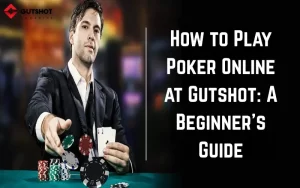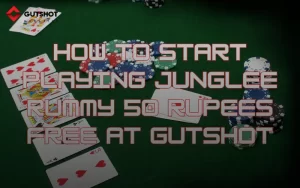One of the most fascinating aspects of poker is the importance of reading people—and the ability to mask your own emotions. The legendary poker face is more than just a look; it’s a crucial skill that can make or break a poker game. Whether playing live in a casino or virtually in an online poker room, mastering the poker face and interpreting body language are essential strategies for any player aiming to win consistently.
In this post, Gutshot explores the art of the poker face, contrasts it with reading body language, and offers winning strategies tailored to both online and offline games. We’ll dive into how these skills differ depending on the medium, the value of a good poker face, and how you can leverage subtle cues to your advantage. By understanding the psychology and physicality of poker, you can boost your winning chances, no matter where or how you play.
The Power of a Poker Face in Poker
The concept of the poker face goes beyond the game itself—it’s become a cultural symbol of emotional control. But in the context of poker, a poker face is an intentional tactic used to hide any facial expressions that might give away the strength of your hand. Professional players are masters of maintaining this neutral expression, which prevents opponents from picking up on tells—subtle cues that might reveal whether they’re bluffing or holding a strong hand.
A true poker face is more than just a blank expression. It requires complete control over emotions, facial muscles, and even breathing. This level of control can intimidate opponents, making it harder for them to read you and ultimately giving you the upper hand. Whether online or offline, honing your poker face can be a game-changer.
Poker Face vs. Body Language in Offline Poker
In live, face-to-face poker games, the poker face is only one aspect of the psychological battle. Body language plays a significant role, as players can pick up on everything from eye movements to subtle shifts in posture. Let’s look at how these elements interact:
1. Reading Physical Tells
In a live game, the body is constantly sending signals, whether intentional or not. Here are some common physical tells and what they might indicate:
- Eye Movements: Players who look at their chips right after seeing their cards may be preparing to bet, which suggests a strong hand. On the other hand, players who avoid eye contact might be bluffing.
- Hand Movements: Nervous or fidgety hands can signal weakness or insecurity. Some players drum their fingers or adjust their chips more often when they’re uncertain.
- Posture: Leaning forward can indicate confidence, while slouching or retracting from the table can suggest hesitation or weakness.
- Breathing Patterns: Rapid breathing or sighing can reveal nerves, especially during high-stakes bets.
Observing and analyzing these tells can give you insights into your opponents’ hands. However, it’s essential to recognize that experienced players are often adept at masking these tells or even using fake tells to mislead others.
2. Mastering the Poker Face
Having a poker face is crucial in live poker, as opponents are constantly analyzing one another. To develop a strong poker face, practice keeping your face neutral, regardless of the cards you hold. Relax your facial muscles and avoid exaggerated reactions, such as smiling, frowning, or raising eyebrows, which can reveal your emotions.
A reliable poker face also extends beyond the face itself. Practice controlling other bodily cues, such as breathing and posture. If you have a habit of fidgeting when nervous, work on grounding yourself and staying still. With practice, your poker face will become a natural, automatic reaction, leaving opponents unable to glean any information from your expressions.

3. Bluffing with Body Language
Incorporating subtle bluffs into your body language is a sophisticated strategy that can take your live poker game to the next level. For example, if you have a weak hand, you might lean forward slightly, as if confident, to make opponents think you’re holding something stronger. Alternatively, appearing disinterested or bored can throw off opponents, leading them to believe you’re not invested in the game.
Poker Face in Online Poker: Strategies for Virtual Play
Online poker adds a new dimension to the game because players cannot see each other face-to-face. In this environment, the traditional poker face is less relevant, as players cannot rely on visual cues like body language or facial expressions. Instead, they must rely on different skills to read opponents and bluff effectively. Here’s how the poker face concept adapts to online poker:
1. Digital Tells
While body language is absent, online poker players leave digital tells through their betting patterns, timing, and chat behavior. Here are some common digital tells to look for:
- Betting Patterns: If a player consistently raises the pot after a few rounds, they may be bluffing to intimidate others. Conversely, players who bet conservatively at first and suddenly go all-in may be holding strong hands.
- Timing: The speed at which players make decisions can reveal confidence or hesitation. Quick, immediate bets often indicate certainty, while long pauses suggest indecision or bluffing.
- Chat Behavior: Some players use the chat feature to either distract or throw off opponents. A player who suddenly becomes quiet during a big bet may be concentrating, hinting at a strong hand, while chatty players may be bluffing to seem relaxed.
2. Creating an Online Poker Face
While the traditional poker face doesn’t apply visually in online poker, you can still create a figurative poker face by playing consistently and predictably. Here’s how to keep opponents guessing:
- Consistent Bet Timing: Avoid drastic changes in timing when making decisions. Whether you have a strong or weak hand, take a similar amount of time to place bets. This consistency prevents opponents from picking up on timing tells.
- Balanced Betting Patterns: Mix up your betting style occasionally to avoid predictability. Alternate between aggressive and conservative betting patterns, regardless of your hand strength, to throw opponents off.
- Avoid Overuse of Chat: Use the chat feature sparingly, as too much engagement can give away your mindset. Keeping quiet or only responding occasionally maintains a level of mystery around your playing style.
3. Bluffing Without Body Language
Without visual cues, online poker requires a more strategic approach to bluffing. Betting patterns become your primary tool for bluffing, as opponents can only interpret your moves based on the stakes you’re raising or folding. Use unpredictable raises or slow-playing a strong hand to keep them on edge. Similarly, downplay big hands by betting conservatively to lure others into the pot, giving you an edge when it’s time to reveal.
Blending Poker Face and Body Language Across Platforms
Many players switch between online and offline games, so knowing how to adapt your poker face and body language across platforms is a valuable skill. Here are some strategies for transitioning between live and online poker effectively:
1. Consistency is Key
Maintain consistency in your approach, whether online or offline. This keeps opponents guessing, especially if they’ve seen you play in both settings. Developing a solid game face in live poker can translate into a reliable betting pattern in online games, creating an overall sense of predictability that actually works in your favor when you choose to deviate.
2. Adjust Your Bluffing Techniques
The bluffing style for online poker requires patience and subtlety, relying on betting sequences rather than body language. In contrast, live poker allows for physical cues, so using a poker face effectively while mixing in physical bluffs adds complexity to your strategy. Recognize which techniques work best for each platform and practice accordingly.
3. Practice Reading Opponents Across Settings
When playing live poker, work on reading opponents’ body language. Observe their reactions to wins, losses, and high-stake moments. Online, focus on identifying digital tells, like betting timing or patterns. By improving your skills in both areas, you’ll be better prepared to tackle any poker setting confidently.
Key Takeaways for Developing a Winning
A successful poker face isn’t about hiding behind a blank expression; it’s about psychological control and consistency. Here are a few key takeaways for developing and refining your poker face:
- Self-Awareness: Understand how your body and face react in high-stress situations. Practice remaining calm and neutral to ensure that emotions don’t show.
- Mindfulness: Stay mindful of each movement at the table, especially in live games, where opponents may scrutinize even the slightest gestures.
- Control Over Emotions: In both online and offline games, stay calm and confident. Emotional control reduces the likelihood of making impulsive decisions and reveals less to opponents.
- Adaptation to Environment: Know when to use your poker face and when to adjust your strategy. Each poker setting has unique demands, and adapting to these is crucial.
Conclusion
Mastering this and reading body language are essential skills for any poker player, whether in online or live settings. 4rabet A solid poker face keeps opponents in the dark about your hand strength, while reading body language or digital tells provides an invaluable edge in interpreting theirs. By blending these skills and adjusting to the nuances of each platform, you can build a well-rounded poker strategy that maximizes your chances of winning.
Gutshot’s guide shows that while the poker face may take different forms across platforms, its importance remains the same. With practice, self-awareness, and adaptability, you can master the poker face and dominate both live and online poker tables. So next time you’re at the table, remember—keep your face calm, your body controlled, and your opponents guessing.


